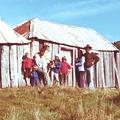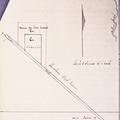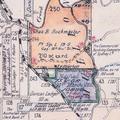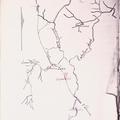< Early Canberra Government Schools
Ledgerton [1897 - 1907]
'Ledgerton'
'Ledgerton' today is a sheep grazing property midway between Yass and Canberra - a portion of the vast 'run' of 22,000 acres first taken up in about 1840 by the locality's pioneering squatter, John Ledger. The property and others nearby have been 'home' to seven generations of Ledger family descendants.
John Ledger (or Ledgard) was born in Wakefield, Yorkshire in 1810. He became a blanket weaver by trade, but at 18 was found guilty of stealing some lead and sentenced to 7 years transportation to New South Wales. He arrived in Sydney Cove on 12th October 1828, disembarking from the convict transport Marquis of Hastings. When his sentence fully expired in 1835 he found work with Abe Hearn, a cooper in Cabramatta. By the late 1830s he was self-employed, carting stores by bullock wagon from Sydney to Yass and returning with bales of wool.
On one of these journeys, John met Mary Ann McFarlane, the daughter of Duncan (and Mary) McFarlane, a farmer on Cavan station, out of Yass. John and Mary were married in Yass on 11th December 1843 - Mary arriving at the church in a bullock dray. The full extent of John's 'run' where they settled in a slab hut, is recorded in an 1848 Government Gazette as follows: -
Ledger, Jon. Name of run Stammer's Forest. Estimated area, twenty-two thousand acres. Estimated grazing capabilities, six hundred and forty cattle. Bounded on the north by Mr Hall's run; on the south by a creek called Euriara Creek; on the east by a range called Mallyon range; and on the west by Mr Beckham's run.
Ledger's run became known as 'Mullion Forest' or 'The Mullion'. Year by year, ring barking and felling of trees made the land more capable of carrying sheep - merinos being favoured for their fine wool clip. Also, for some years the couple and their growing family shared their property with its indigenous people. For example, family lore has it that local Aborigines would gather for an annual corroboree on a nearby creek-side flat, sometimes knocking on the homestead door for food. John and Mary's daughter Annie, born in 1846, was the first of their 11 children - two boys of whom died in infancy. In 1867 she accepted Charles Frederick Walker's hand in marriage, when both of them were 20.
Born in Stepney, Middlesex, Charles Walker was the son of a ship's steward whose wife and children migrated to New South Wales slightly ahead of him in 1857. Charles attended Fort Street school in Sydney, then moved to Yass as a young man. He started work as a bullocky, carting and selling supplies to goldminers in the area, and by the time he married Annie, he had progressed to 'Grazier, Ledgerton'. It seems by now he was either employed by, or in partnership with his father-in-law – both men being involved in the carting of wool to Sydney, as well as farming.
By this time, the 1861 Land Act had begun to 'unlock' squatting runs to enable small acreages within a run to be conditionally purchased from the Crown. It then became a contest between a squatter's extended family and/or their stand-ins (derogatively called 'dummies') versus 'free selectors', when these blocks of land were advertised by the government. One such free selector, a Dutch dairy farmer named Jules de Smet, bought Portion 182 of John Ledger's run, a choice block next to Mullion Creek. De Smet and his family farmed there for some years before Charles Walker managed to regain the farm in the 1870s, thereby returning it to the large amount of surrounding land gradually reclaimed by John Ledger's extended family.
At about the time John and Mary Ledger retired to Yass in 1878, Charles and Annie Walker settled on the former dairy farm, transferring the name of 'Ledgerton' to it. In the years that followed they extended their property and raised 11 children, the younger of whom, along with other local children, would later attend Ledgerton school.
(Main ref.: Warren Walker, The Walkers of Ledgerton, Yass, 1668-2013, W. Walker, Tamworth, NSW, 2013)
The quest for a school
The parents' need for a school at Ledgerton increased when the closest school, Yumburra (or Yeumburra) West, closed due to insufficient pupils in 1895. Four miles closer to Yass, Yumburra West had been close to the limit of travelling distance for any Ledgerton-Mullion pupils, but had been their only accessible school for 10 years.
In May 1896, the Department of Public Instruction received simultaneous requests from Charles Walker, spokesperson for Ledgerton parents, and William McLaughlan, spokesperson for Uriarra (20km south of Ledgerton). As both districts had insufficient pupils to qualify for full-time schools, they requested that the Department consider opening two half-time schools - a common operation in small bush communities, whereby a single teacher conducted school half-weekly in two fairly close districts.
(For all Dept. of Educ. references: 'Ledgerton School', 5/16574.2, NSW Archives)
The next month, Yass-based district inspector of schools, Patrick F Sheehy, visited both localities to attend to the matter. He reported that both places had the requisite pupil numbers to be half-time schools, and that the Uriarra parents had a disused church that could be made suitable for a schoolroom; Ledgerton parents, however, not having a schoolroom, would need to build one before the Department could approve the joint request.
When the Ledgerton representatives agreed to this, Inspector Sheehy had both groups complete formal applications. Ledgerton's was signed by Charles Walker, Duncan Ledger, Samuel Ledger and Thomas Leonard - all of whom are listed 'farmer and grazier' by occupation. The proposed schools were about 11 miles apart, and at Ledgerton a teacher could be accommodated at Mr Charles Walker's residence. Ledgerton's 16 pupils came from four families: Charles Walker's (Church of England) children, Kate 11, Allan 9 and Terrent 7; Caroline Ledger's (Church of England), Leslie 10, Mildred 9, Charles 7, Maud 6 and Archibald 5; Sarah Ledger's (Church of England), Earnest 13, Edith 10, Gordon 7 and Mary Ann 6; and Thomas Leonard's (Roman Catholic), Hector 12, Grace 10, William 8 and Furgus 6.
The school inspector selected a suitable site on crown land close by, and returned sketch maps to assist the Lands Department's formal dedication of it (photos below). These recommendations approved in July 1896, the next step required was that Ledgerton representatives submit a building plan. Regarding this, Charles Walker wrote to the Minister of Education proposing a simple solution: -
We the parents of the children of the Ledgerton half time school beg that you will grant us permission to remove the old Yumburra West school building and furniture to the Ledgerton school site.
The old school building is not required at its present site as there is no children at all under 14 years within 3 miles.
The parents will remove it and re-erect it on the Ledgerton site and will make good any damage done to it free of cost.
Trusting you will see fit to comply with our request
We have the honour... (etc) CF Walker - on behalf of the parents
Approved in September 1896, the school was relocated within a month. On 26th October, Walker wrote to both the Departmental under secretary and Inspector Sheehy, saying that the building was in place and ready for inspection. 'The matter appears to be urgent' a chief inspector remarked, directing Sheehy to inspect it at the first opportunity. Sheehy did so, reporting on 4th November that, subject to installing a gutter for the building's 400 gallon water tank, Ledgerton school had 'sufficient supply of school materials and is fit for occupation'.
The Ledgerton-Mullion parents had every reason to be pleased with their achievement, none more so than Charles Walker who had represented them most ably for a year and a half.
The first teacher, William Faulder
Appointed during the summer holidays, William Faulder opened the school in January 1897. Aged 27 and single, he was the youngest son of Thomas Faulder of Yass. While lodging at Charles and Annie Walker's residence, he became romantically attracted to their 17-year-old daughter Isabella Ann (also known as Annie). Later in the year, when he applied to re-sit a teacher's examination he had just failed, Faulder explained to Inspector Sheehy that he wanted to improve his position, as a married man especially: -
Having failed my recent examination, I have the honour to request that you will recommend my application to be examined again in June 1898...
Further, I wish to mention that I am engaged to be married to Miss Walker of Ledgerton and have obtained this young lady's parents' consent to marry her. I have become ambitious, as it were, to improve my position and it would be a great disappointment if I were refused permission to be examined in June next.
If allowed to sit, I am determined to study assiduously and feel almost confident of success.
I have the honour...(etc) William Patrick Faulder, Teacher
When they married in January 1898, the couple moved into a cottage at Uriarra. The outcome of William's mid-year examination is not evident, however as they had a baby daughter at the end of that year, his promotion to a higher teaching salary would have been welcomed by them.
By then they were finding the Uriarra location unhealthily cold in winter. Before a second winter there, Faulder wrote to Inspector Sheehy applying to be transferred to a warmer district, to improve his own worsening health especially: -
... I am suffering with an affection to my lungs, and have been under medical treatment for the past eight months ... The climate of Uriarra is extremely cold in winter...(and) as the distance between the schools is about eleven miles, I have frequently to be out in wet weather and when there is a heavy fall of snow ... A repetition of this winter would cause me to get a relapse which, in my present state of health, would more than probably have a very serious result. I would prefer a full-time school situated in the Junee or Cootamundra districts, or in a warmer part of the Yass district, and within about 10 miles of a town so that I could obtain medical attention ... Mine is an extreme case and requires urgent attention, as it is only by taking the greatest care and attention that I can recover from the complaint with which I am suffering.
Twice in 1899, Inspector Sheehy recommended that Faulder's requested move be granted. In the meantime however, Faulder found much better accommodation near Ledgerton and withdrew his request to be moved. The residence they had moved into belonged to John Walker of 'Fairbank', who had vacated his home for a time after his wife died. As Faulder explained to Sheehy, he was now better placed to reach either school, being 2½ miles from Ledgerton and 8½ miles from Uriarra. His letter included a request that the Department pay his annual rent of 25 pounds, which was deemed acceptable and approved.
As customary in small bush schools, annual school picnics were usually a big event, involving the whole community. Ledgerton school's first picnic, held jointly with Uriarra in November 1897, was described as follows by the Queanbeyan Observer :-
About 40 children and 80 adults sat down to an excellent spread provided by the following ladies, viz., Mesdames Walker, Webb (2), Ledger, Buckmaster, Leonard, McDonald, Flanagan, McLaughlan and Blundell, and those ladies must be complimented for the kindly interest they displayed from the start to make the picnic the success it was. Prizes amounting to 8 pounds were run off under the directorship of Messrs Faulder, Leonard, Walker, Webb, W McDonald and Morton McDonald while Miss Eliza Webb and Miss Walker distributed the prizes among the lucky winners. To these young ladies the credit of having collected and purchased the prizes must be given. During the afternoon, games etc., were indulged in and shortly after sundown cheers were given to the visitors and parents of the children and after they had been responded to by the teacher, a start was made for home, everyone entertaining happy recollections of the Ledgerton-Urayarra (sic) combined school picnic and expressing the hope that it may become an annual affair.
Contagious epidemics would occasionally sweep through a school, often infecting the teacher as well. On 27th April 1900, Faulder wrote to Inspector Sheehy about one such epidemic: -
I have the honour to inform you that, as Whooping Cough is now prevalent in the district, my little daughter, aged one year and six months has caught the infection. As it is impossible for me to isolate myself, I beg to apply for permission to close the Schools under my charge till the risk of conveying the infection to the scholars has passed. Please, reply, if possible, on Monday next, so as to enable me to receive it by Tuesday's mail.
The inspector recommended that Faulder be permitted to close his schools until the risk of contagion had passed, which was duly approved. The two schools were closed from 12th to 26th May - welcomed, no doubt, by pupils who hadn't succumbed to the sickness.
In October that year, Faulder was transferred to the half-time schools at Kangiara Creek and Tangmangaroo. He went on to have a long and successful teaching career before retiring to Goulburn where he died in 1947, in his 78th year. An obituary recorded that William Faulder 'had one of those quiet, charming and unassuming personalities which made him beloved of his scholars and held in the highest regard by the parents and his many friends'. (Trove: Picton Post, 6 March 1947)
Teacher John Adam
The next teacher, John Adam, was 22 when appointed to Ledgerton-Uriarra schools in November 1900. Being single, he was offered board by Charles and Annie Walker and soon became romantically attracted to their 19-year-old daughter Sarah Grace (known as Ruby) They were married on 19th December 1901 at the Presbyterian Church in Yass, and succeeded the Faulders in renting John Walker's residence at 'Fairbank'.
A problem arose in April 1903 when John Walker required the homestead for himself. Adam could find no similar accommodation and as the Department's lease was soon to expire, he requested to be transferred to another school with an attached residence as soon as possible. His long letter to Inspector Sheehy graphically illustrates the challenges many teachers experienced in remote bush schools, serving at half-time schools especially: -
I have the honour to forward herewith, notice to quit tenancy, which I have received from the owner of the house I am occupying. I am informed that he intends to remarry and requires his house as a residence for his wife and himself. ... I have tried by every means within my power to procure other accommodation in the district and have failed... I am classified 3A and have been in charge here for upwards of 3 years, having never had a vested residence. During my term here I have been under very heavy expense for fodder and carriage on life's necessities – the schools being extremely isolated.
The residence I am occupying is over 8 miles from Uriarra school and about 4 miles from Ledgerton school, and this compels me to be in the saddle every day over rough roads.
My wife has had to undergo hardships for a lady, in attending school for the tuition of sewing, over very bad roads and in all weathers. My present home is at least 2 miles from the nearest neighbours and the lonely life thus entailed on my wife and made worse by my daily absence, has under mined her health and made her exceedingly low spirited and melancholy, so much so that it is absolutely necessary for her to be in a place where she would not be so lonely ...
On account of Yass district being my wife's native place she would like a home somewhere in it. I, myself, would prefer a school in the Yass inspectorate. Failing a suitable vacancy in this inspectorate, I ask that I may be promoted to some charge situated within the coast district.
Inspector Sheehy gave Adam his full support, commenting that he was a capable, deserving teacher. In July 1903 he was appointed temporarily to Wargella public school, then transferred to Macquarie-street South school in Sydney. He went on to have a long and successful career, rising to school inspector in 1931.
Teacher John Coddington
Ledgerton-Uriarra was John T. Coddington's first appointment after finishing his pupil-teacher training in 1903. Aged 17 and on probation, his annual salary was ₤72. Like his predecessors, Coddington also became attracted to a local girl: Charlotte Annie Webb, the daughter of William and Jane Webb (nee Ledger) of 'Fairlight', Uriarra. They were married in April 1906, and took up residence near Charlotte's parents at Uriarra.
According to a Ledger family memory, John Coddington was an overly strict disciplinarian; though on one occasion, well remembered by the pupils, they lightened their day with a novel prank to get revenge: -
Mr Coddington had very strict and cruel teaching methods. I know this because the Newman boys took their little sister home one afternoon with swollen and bruised hands which developed into a ring of blood blisters. Mrs Newman was furious, she fronted up to Mr Coddington and verbally tore strips off him and threatened that if it ever happened again to any of the children she would report him to the local authorities. However as the story goes, the children had their own revenge.
Mr Coddington used to sit on an old stump outside to watch the children at lunch. Pulling himself up with his two hands to land in the centre of the stump with a contented sigh. One day he landed with a scream. The kids had sharpened a large homemade tack and had put it in a crack in the stump. When Mr Coddington came down with all his weight ... it was not a contented sigh he made. The kids all had smug faces.
(Shirley Faulder, (nee Ledger), memoir written for The Mullion school, 2017)
Like both teachers before him, Coddington found his working conditions increasingly difficult to cope with: the bleak winters at Uriarra and tiring travel in all kinds of weather exacting a heavy toll on his health. In 1907, after failing to obtain a transfer, he applied to resign, then on second thoughts changed his mind - as explained to a chief inspector in Sydney: -
I have the honour to inform you that... I do not wish to resign my position as teacher. If it is impossible to grant leave of absence, I would be contented with a removal to another school in a drier climate.
I have been stationed at these two half-time schools for nearly 4 years, and as it is a very wet and boggy place I have developed colds and rheumatism ... I trust you will not insist upon me resigning as when I was 3 years of age, I had the misfortune to lose my foot, which would render me incapable of performing hard labour, and furthermore my wife is almost out of her mind to think I will have to leave the Service.
Trusting you will appoint me to another school at Easter....
Due to insufficient pupils the two schools were closed that same Easter, so John Coddington obtained the transfer he had sought. He was moved to Burrumbuttock provisional school, near Albury, but soon left the teaching service, resigning six months later on 31st October 1907.
Ledgerton subsidised school
The subsidised school scheme was first introduced in 1903 to assist isolated families who could not afford governesses. To obtain a subsidy of up to 25 pounds per annum, two or more families had to engage a private teacher and provide the salary, lodging and a place to teach - the subsidy helping to defray their outlay.
If enrolments stabilised sufficiently, a subsidised school could become, or return to, a public school - as did Uriarra; but more often they had a brief life, especially after correspondence education began in 1916. The other alternatives for parents were to engage private tuition from a governess or send their children to boarding schools.
After Ledgerton closed as a government school, its recorded history is fleeting: Miss Ivy Dowling was appointed in April 1910; 'a lady teacher' was sought for Ledgerton subsidised school in 1911; and the teacher Miss Jessie Worner given a fond farewell by the community in 1913: -
A very pleasant and enjoyable afternoon was spent at the residence of Mr and Mrs D. Ledger's, " The Mullion" on Friday, August 22nd, the occasion being a farewell and presentation to Miss Jessie Worner who has for the last two years held the position of subsidised school teacher at Ledgerton. At eight o'clock dancing commenced and was kept merrily going until midnight when the company adjourned to the supper room.
... Mrs Ledger presented Miss Worner with a handsome, gold bracelet as a mark of esteem and appreciation from the parents and friends ... and Miss Ida Walker presented on behalf of the pupils, their teacher with a silver backed hair brush and comb, and little Miss Money Walker handed Miss Worner a beautiful bouquet of flowers. On rising to respond, Miss Worner was accorded quite an ovation. She said she was very sorry at having to leave so many warm friends and thanked them sincerely for their kindness that night and for the very handsome presents. After ample justice had been done to the very excellent supper all adjourned to the ballroom where dancing was kept up merrily till the sma' wee hours of the morning when all joined hands and sang "Auld Lang Syne". A move was then made homewards, everyone voting that they had spent a very jovial and enjoyable evening.
(Trove: Queanbeyan Age, 29 August 1913)
In September 1915, Duncan Ledger informed the Department of Public Instruction's under secretary that he was interested in purchasing the old Ledgerton school for 3 pounds. It had not been used for over 4 years, he wrote, and the premises were in a state of complete ruin. For the sum offered, he would fully clear all that remained of the school building from its crown land site. The Department accepted his offer providing he paid a deposit of 1 pound 'as a guarantee that the conditions of the sale would be kept' – that is, not leave any materials on site.
One last memo about the school refers to Ledger still seeking to be repaid in July 1917: 'Is there any reason why the deposit should not be refunded?' asks the Department's accountant; 'Has the condition of sale been satisfactorily carried out?' queries an under secretary. After further inquiries between the new and former Yass inspectors, Duncan Ledger was refunded his pound.
(Contributed by Keith Amos, former teacher at The Mullion school)
Location Map
Related Photos
Teachers
- Faulder, Mr William Patrick
Half Time, 01/1897 - 10/1900 - Adam, John
Half Time, 11/1900 - 07/1903 - Coddington, John T.
Half Time, 07/1903 - 04/1907
NSW Government schools from 1848
- Ledgerton (external link)
< Early Canberra Government Schools
If you are able to assist our work of identifying, documenting, and celebrating the early bush schools of the Canberra region, please contact us or .






